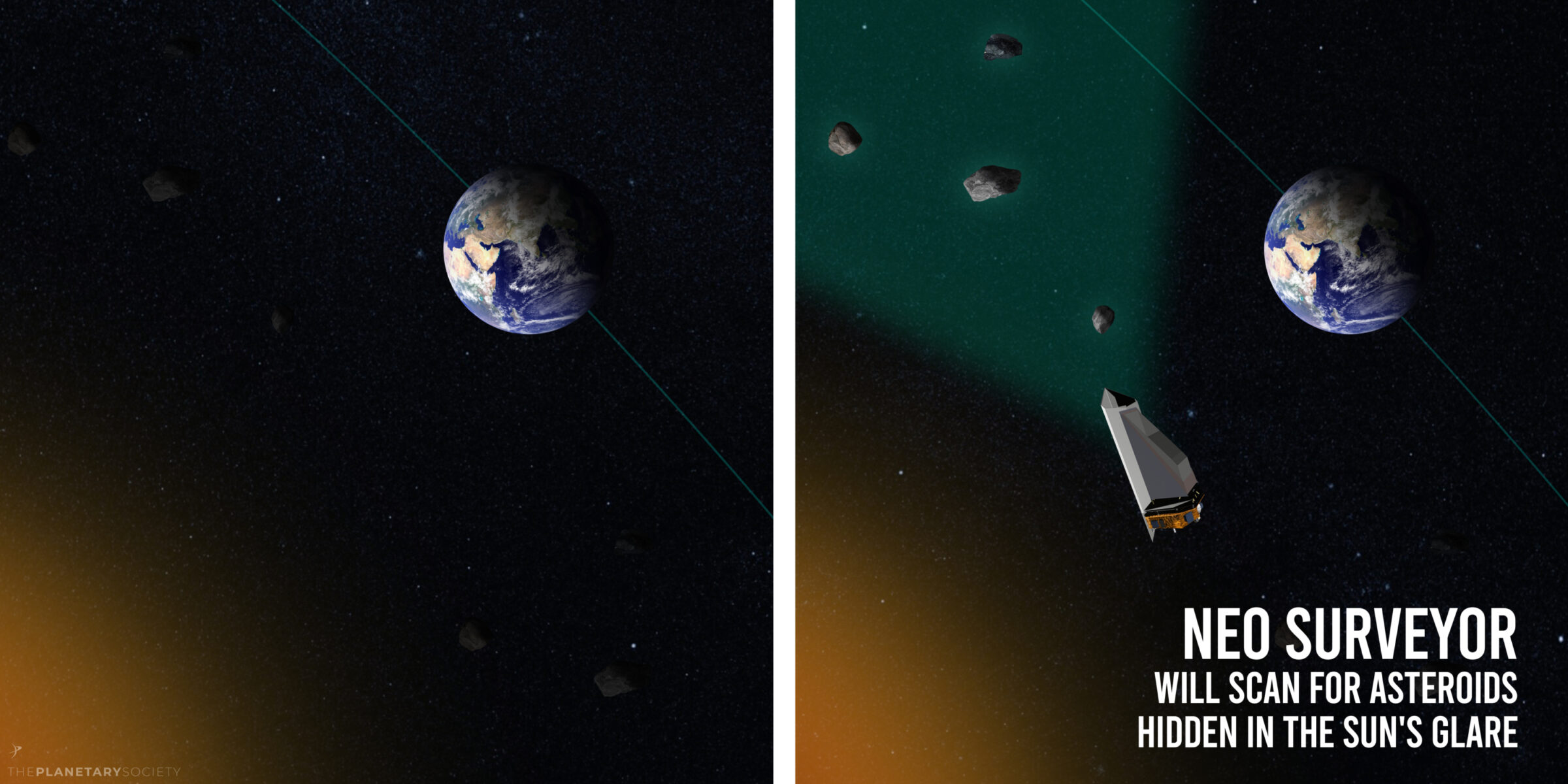NEO Surveyor, protecting Earth from dangerous asteroids
Highlights
- NASA’s NEO Surveyor mission aims to discover asteroids and comets that could potentially hit Earth.
- NEO Surveyor will find 90% of near-Earth objects (or NEOs) with diameters of at least 140 meters (460 feet). A direct hit from an object that large could level an entire city.
- The Planetary Society is committed to defending Earth from impacts, and our members and space advocates have worked tirelessly to help keep NEO Surveyor on the launchpad.
Why search for near-Earth objects?
Space may be vast, but it’s not empty. Earth is bombarded by tiny space rocks every day, most of which burn up in our atmosphere. Larger objects, like the one that exploded over Chelyabinsk, Russia in 2013, can damage buildings and cause minor injuries. On rare occasions, a huge asteroid or comet will strike Earth and cause global devastation — like the gigantic impact 66 million years ago that put an end to the dinosaurs.
Fortunately, NASA and other space agencies are developing the technology to deflect near-Earth objects (NEOs) on course to hit our planet, with missions like the Double Asteroid Redirection Test (DART). But before we can stop any threats, we have to find them. In 2005, the U.S. Congress ordered NASA to find 90% of the estimated 25,000 NEOs larger than 140 meters (460 feet) — the rough size threshold at which an object can level an entire city. The deadline was 2020, but so far, we’ve found just 43% of our goal. At the current detection rate, it would take another 30 years to finish the job.
The Near-Earth Object (NEO) Surveyor mission is designed to pick up the slack. Scheduled to launch in 2027, it aims to meet the Congressional goal of 90% detection within 10 years. By finding and studying near-Earth objects, NEO Surveyor will not only help us figure out if anything is on a collision course with Earth, but will also help lay the groundwork for potential survey and deflection missions in the future.

How NEO Surveyor Works
NEO Surveyor will be a space-based infrared telescope. After its launch date in September 2027 (June 2028 at the latest), NEO Surveyor will park itself at the Sun-Earth L1 Lagrange point, a spot 1.5 million kilometers (930,000 miles) away where the gravitational pull from the Sun and Earth balance in a way that allows spacecraft to stay in stable, efficient orbits. From thereNEO Surveyor will be able to look ahead of and behind Earth’s orbital path, spotting asteroids that we otherwise wouldn’t be able to see because of the Sun’s glare. The telescope will then begin a five-year baseline mission with the goal of detecting two-thirds of all potentially hazardous asteroids larger than 140 meters (360 feet) in diameter.
NEO Surveyor will be much more efficient than ground-based surveys, which can be affected by bad weather, have a harder time discovering small bodies near the Sun, and often lack coverage of the Southern Hemisphere. At the same time, observing in the infrared will allow NEO Surveyor to find dark asteroids that would otherwise be hard to see. Though infrared light is invisible to human eyes, asteroids can be detected in the infrared because of how they re-radiate heat from the Sun back into space.
NEO Surveyor is also slated to be far more capable than NASA’s current planetary defense-related space telescope, the Near Earth Object Wide-Field Infrared Survey Explorer (NEOWISE). NEOWISE launched in 2009 and was originally an astrophysics mission before it was repurposed as an asteroid hunter in 2013. Though NEOWISE has discovered hundreds of asteroids, it is not optimized for the job in the ways NEO Surveyor will be. NEOWISE has a smaller telescope mirror and sits in Earth orbit, which limits its search capabilities. The spacecraft’s orbit is also currently drifting. Soon, it will not be able to observe asteroids without stray light entering the telescope.

Who is leading the NEO Surveyor mission?
NEO Surveyor is being led by NASA in partnership with the University of Arizona, NASA’s Jet Propulsion Laboratory (JPL), and Caltech/Infrared Processing and Analysis Center (IPAC). The principal investigator of the science mission team is Amy Mainzer, professor at the Department of Planetary Sciences and the Lunar and Planetary Laboratory at the University of Arizona. The spacecraft itself is being built by a number of contractors, including Space Dynamics Laboratory, Ball Aerospace, and Teledyne Imaging Sensors. The NEO Surveyor project is funded by NASA’s Planetary Defense Coordination Office as part of NASA’s planetary defense efforts.
Support missions like NEO Surveyor
Whether it's advocating, teaching, inspiring, or learning, you can do something for space, right now. Let's get to work.


 Explore Worlds
Explore Worlds Find Life
Find Life Defend Earth
Defend Earth


